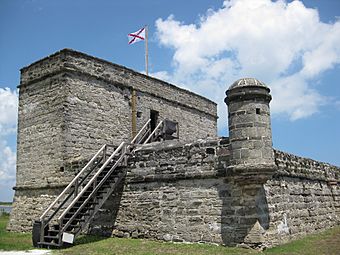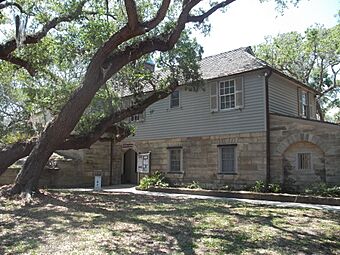Fort Matanzas National Monument facts for kids
|
Fort Matanzas National Monument
|
|

View of fort's western and southern façades
|
|
| Location | St. Johns County, Florida, US |
|---|---|
| Nearest city | St. Augustine, Florida |
| Area | 227.76 acres (0.91 km²) |
| Built | 1740-42 |
| Visitation | 1,002,444 (2005) |
| Website | Fort Matanzas National Monument |
| NRHP reference No. | 66000098 |
Quick facts for kids Significant dates |
|
| Added to NRHP | October 15, 1966 |
| Designated NMON | October 15, 1924 |
Fort Matanzas National Monument is a special place in Florida. It's where the Spanish built a fort long ago. This area became a United States national monument on October 15, 1924.
The monument includes the old Spanish fort, built in 1740, and about 100 acres (0.4 km²) of salt marsh and barrier islands. These lands are found along the Matanzas River on Florida's northern Atlantic coast. The National Park Service takes care of Fort Matanzas. They also manage the Castillo de San Marcos National Monument in St. Augustine.
Why the Fort Was Built
Fort Matanzas was built by the Spanish in 1742. Its main job was to guard Matanzas Inlet. This inlet was the southern entrance to the Matanzas River. It was important because enemies could use it to sneak into the city of St. Augustine from the back.
Protecting St. Augustine
Using the inlet meant avoiding St. Augustine's main defenses. These defenses were centered around the strong Castillo de San Marcos. In 1740, Governor James Oglethorpe from Georgia used this inlet. He blocked St. Augustine and attacked the city for 39 days.
Building the Fort
St. Augustine survived Oglethorpe's attack. But this event showed the Spanish they needed to protect the inlet. Governor Manuel de Montiano ordered the fort's construction. Work began in 1740 and finished in 1742.
Fort Design and Workers
Engineer Pedro Ruiz de Olano designed the fort. He had also worked on the Castillo de San Marcos. Convicts, slaves, and soldiers from Cuba helped build it. The fort was placed on what is now Rattlesnake Island. From there, it could watch over Matanzas Inlet.
What the Fort Looked Like
The Spanish called the fort Torre de Matanzas, meaning Matanzas Tower. It was made of coquina, a strong stone made from shells. The ground was marshy, so pine logs were used to create a strong base.
Fort Size and Soldiers
The fort was about 50 feet (15 meters) long on each side. It had a 30-foot (9-meter) tall tower. Usually, one officer, four soldiers, and two gunners lived there. More troops could be sent if needed. Soldiers rotated from their regular duties in St. Augustine.
Cannons for Defense
Five cannons were placed at the fort. Four were six-pounders, and one was an eighteen-pounder. All the cannons could reach the inlet. At that time, the inlet was less than half a mile away.
The Fort's Only Battle
In 1742, as the fort was almost done, the British arrived. Governor Oglethorpe led twelve ships toward the inlet. The fort's cannons fired at the British scouting boats. The warships then left without attacking the fort directly. This was the only time Fort Matanzas ever fired on an enemy.
Changes in Control
Spain lost control of Florida in 1763 with the 1763 Treaty of Paris. They got it back in 1783 with the 1783 Treaty of Paris. But the Spanish Empire was weakening. Spain did not spend much effort keeping the fort in good shape after this.
Becoming a Ruin
When the United States took over Florida in 1821, the fort was in bad condition. It was so damaged that soldiers could not live inside. The United States never used the fort, and it became a ruin.
The Name "Matanzas"
Fort Matanzas got its name from the inlet. The inlet was named after a sad event in 1565. The Spanish executed, or matanzas (which means slaughters in Spanish), Jean Ribault and his French friends on the north shore. These Frenchmen were the last of the Fort Caroline colonists.
Restoring the Fort
In 1916, the U.S. Department of War started a big project. They wanted to restore the fort, which was falling apart. By 1924, they had fixed cracks in the walls and made the structure stable.
National Monument Status
In the same year, 1924, Fort Matanzas was declared a National Monument. On August 10, 1933, it moved from the War Department to the National Park Service. Because it's a historic site, it was added to the National Register of Historic Places on October 15, 1966.
Visitor Center and Headquarters
|
Fort Matanzas NM Headquarters and Visitor Center
|
|

Visitor center
|
|
| Location | 8635 A1A S., St. Augustine, Florida |
|---|---|
| Built | 1936 |
| Architect | NPS Eastern Div. of Plans & Design |
| Architectural style | NPS Rustic |
| MPS | Florida's New Deal Resources MPS |
| NRHP reference No. | 08001245 |
| Added to NRHP | December 31, 2008 |
The Fort Matanzas National Monument Headquarters and Visitor Center was built in 1936. It is located at 8635 A1A. This is about 15 miles (24 km) south of St. Augustine, Florida.
What You'll Find There
The center is on Anastasia Island. It serves the Fort Matanzas National Monument, which is a short boat ride away. The National Park Service's Eastern Div. of Plans & Design designed it. It uses a style called National Park Service Rustic. The center also has a museum.
Visitor Center Buildings
The main building has two stories. It has an arched walkway that serves as the visitor center. It also includes a home for a park ranger. The first floor walls are made of coquina stone. The second floor is made of wood with wood siding. It has a hipped roof.
Other Buildings and Features
A smaller, one-story building is about 50 feet (15 meters) north. It also has a hip roof and coquina walls. This building was for utilities but now serves as a ranger office. Visitors wait at the center to take a five-minute boat ride to the historic Fort Matanzas. The fort is across Matanzas Inlet on Rattlesnake Island.
Designed Landscape
Architects from the National Park Service also designed the buildings and the surrounding area. This included flagstone walkways, an outdoor staircase, a retaining wall, and parking areas.
Gallery
See also
 In Spanish: Fuerte Matanzas para niños
In Spanish: Fuerte Matanzas para niños
- Fort Matanzas National Monument Headquarters and Visitor Center
- List of national monuments of the United States
- For the history of the name "Matanzas" see Matanzas River.
- Hispanic Heritage Site












